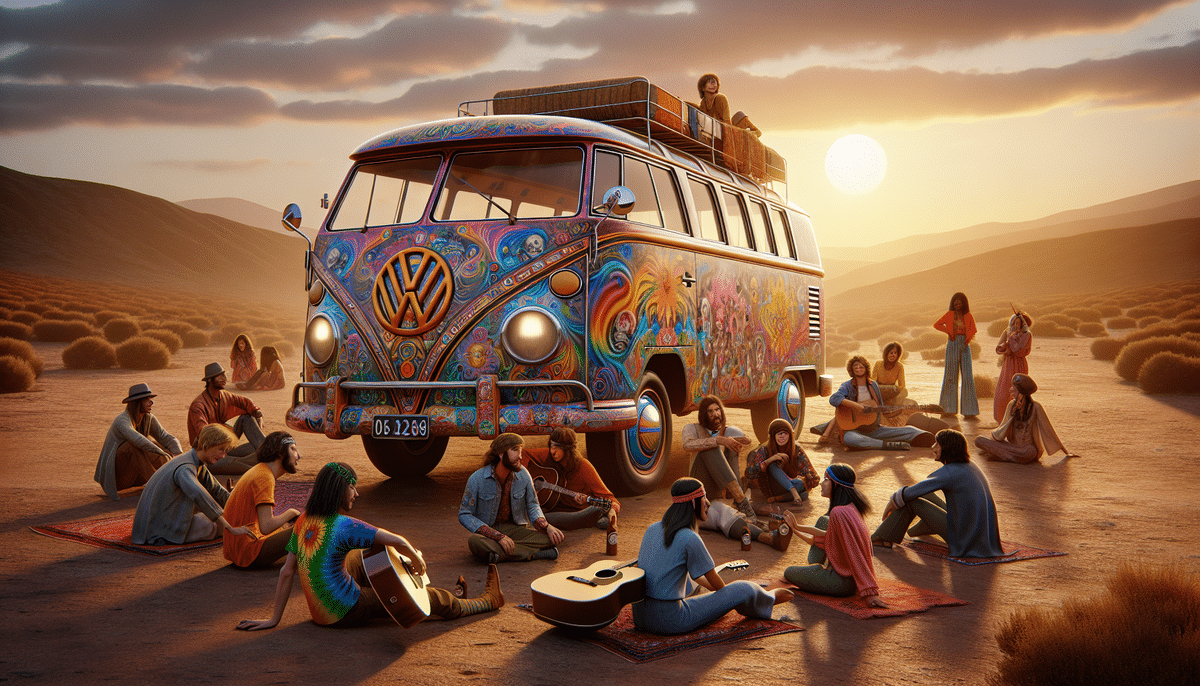The Rise and Fall of the Grateful Dead’s Deadhead Culture
In the 1960s and 70s, the Grateful Dead emerged as one of the most influential bands of their time. Their innovative music and immersive live performances quickly cultivated a devoted fanbase known as Deadheads. This article explores the rise and fall of the Grateful Dead’s Deadhead culture, examining its profound impact on music and American society.
Origins of Deadhead Culture
How the Grateful Dead’s Music and Culture Gave Birth to Deadhead Following
Drawing inspiration from folk, blues, and psychedelic rock, the Grateful Dead crafted a unique sound that resonated deeply with audiences. Their emphasis on improvisation and spontaneity fostered a dynamic connection between the band and their listeners, making each performance a one-of-a-kind experience. This approach not only entertained but also served as a vehicle for personal transformation and spiritual exploration.
As the band's popularity surged, so did the community of Deadheads. These fans were distinguished by their dedication to the band, iconic tie-dye apparel, a penchant for psychedelic substances, and a commitment to a free-spirited lifestyle. Deadheads often traveled extensively to attend multiple shows, forming tight-knit bonds and creating a mobile, communal culture around the band's music.
The legacy of the Grateful Dead continues to influence both fans and musicians. Their dedication to musical exploration has inspired countless artists to push creative boundaries, while the enduring Deadhead community gathers at festivals and concerts to celebrate the band's enduring legacy.
Understanding the Significance of Deadhead Culture in the 60s and 70s
The 1960s and 70s were a time of significant social and cultural upheaval, marked by the counterculture movement's rejection of mainstream norms. Deadhead culture epitomized this spirit, promoting alternative values such as communal living, resource sharing, and uninhibited self-expression. The use of psychedelic drugs among Deadheads was seen as a means to achieve higher consciousness and spiritual enlightenment.
The Grateful Dead's emphasis on live performances as immersive, communal events further solidified Deadhead culture. Each concert's unique, improvisational nature fostered a strong sense of community and camaraderie among attendees. This approach not only influenced the music industry by encouraging artistic experimentation but also contributed to the broader countercultural movement advocating for social and cultural change.
The Evolution and Growth of the Deadhead Community
The Evolution of Deadhead Culture from a Small Group of Fans to a Massive Following
As the Grateful Dead's tours expanded, so did their fanbase. Deadheads became a constant presence at concerts, their influence extending beyond live performances into everyday life. Communal living arrangements and shared resources became common among fans, reinforcing the tight-knit nature of the community.
The band's open policy allowing fans to record and distribute live performances significantly contributed to the spread of their music and the growth of Deadhead culture. This grassroots distribution method fostered a sense of ownership and participation among fans, further strengthening the community.
Despite facing criticism for being perceived as irresponsible or overly idealistic, Deadheads viewed their culture as a meaningful alternative to mainstream societal values, emphasizing individuality and freedom.
The Impact of Live Performances on Deadhead Culture
The Grateful Dead's live performances were central to Deadhead culture. Renowned for their improvisational style, each concert offered a unique musical journey that encouraged fans to attend multiple shows in a single tour. This dedication fostered a strong sense of community and loyalty among Deadheads.
Innovative elements such as psychedelic light shows and elaborate stage designs enhanced the concert experience, creating an immersive environment that captivated audiences. The band's commitment to delivering a distinctive and engaging live experience cemented their status as pioneers in the music industry.
The Role of Psychedelic Drugs in Shaping Deadhead Culture
Psychedelic drugs like LSD and psilocybin were integral to Deadhead culture, often used to enhance the musical experience and explore altered states of consciousness. The Grateful Dead's music, characterized by its "trippy" and "psychedelic" qualities, provided an ideal soundtrack for these experiences.
While these substances facilitated deeper connections among fans and the music, they also led to challenges such as addiction and mental health issues. Band members, including Jerry Garcia, struggled with substance abuse, highlighting the complex relationship between creativity and dependency within the Deadhead community.
Despite these challenges, the influence of psychedelic culture on Deadhead ethos endures, continuing to inspire new generations of fans and musicians.
Influential Figures and Legacy
The Influence of Jerry Garcia on the Grateful Dead’s Music and the Deadhead Community
Jerry Garcia, the Grateful Dead's lead guitarist, was the driving force behind the band's distinctive sound and the heart of Deadhead culture. His eclectic guitar style, blending elements of rock, blues, and jazz, became a hallmark of the band's music. Garcia's charismatic presence and deep connection with fans fostered intense loyalty and devotion within the Deadhead community.
Garcia's untimely death in 1995 marked the end of an era for the Grateful Dead, but his influence persists. His innovative playing style continues to inspire musicians, and the Deadhead community remains vibrant, celebrating his legacy through ongoing gatherings and musical tributes.
The Role of Bootleg Recordings in Spreading the Grateful Dead’s Music and Building the Deadhead Community
The Grateful Dead's encouragement of fans recording and sharing live performances was revolutionary, leading to a thriving bootleg recording culture. These recordings facilitated the widespread distribution of the band's music, fostering a shared cultural heritage among Deadheads.
This grassroots approach to music distribution challenged traditional industry norms and anticipated modern trends like live streaming and official live releases. The exchange of bootleg recordings not only expanded the band's reach but also reinforced the communal spirit that defined Deadhead culture.
Commercialization and Cultural Shifts
The Rise of Commercialization and Commodification of the Grateful Dead’s Music and Merchandise
As the Grateful Dead's popularity grew, so did their commercial appeal. The band's music and merchandise became lucrative, attracting mainstream attention and expanding their fanbase. However, this commercialization sometimes clashed with the core values of Deadhead culture, which emphasized anti-materialism and communal sharing.
Some Deadheads perceived the increasing commercialization as a threat to the band's authentic spirit, leading to tensions within the community. Balancing commercial success with the preservation of cultural integrity remained a complex challenge for both the band and their fans.
How Changes in the Grateful Dead’s Music Affected the Dynamics of the Deadhead Community
The Grateful Dead's willingness to experiment and evolve musically resulted in significant changes to their sound over the years. While this innovation attracted new fans, it also sparked debates within the Deadhead community about the band's direction.
Some fans embraced the new musical directions, appreciating the band's continuous growth and creativity. Others felt a disconnect, longing for the band's original style and fearing that the evolution compromised the group's foundational values.
These internal dynamics highlighted the challenges of maintaining a unified community amidst artistic change, illustrating the complex interplay between innovation and tradition within Deadhead culture.
Decline and Continued Legacy
The Decline and Eventual Dissolution of the Grateful Dead and Its Impact on the Deadhead Culture
By the 1990s, internal tensions and personal struggles led to the Grateful Dead's decline and eventual dissolution. The passing of Jerry Garcia in 1995 was a pivotal moment, leaving the Deadhead community without its central figure.
Despite the band's dissolution, the essence of Deadhead culture endured. Tribute bands, annual festivals, and dedicated fan gatherings continued to honor the Grateful Dead's legacy, ensuring that the spirit of the community remained vibrant.
Contemporary Manifestations of Deadhead Culture, Including Tribute Bands and Festivals
Modern-day manifestations of Deadhead culture include numerous tribute bands and large-scale festivals that celebrate the Grateful Dead's music and ethos. These events serve as communal gatherings where fans can relive the musical experiences and foster new connections within the community.
Festivals such as Dead & Company and Dead Head Summer Festival attract thousands of attendees, demonstrating the enduring appeal and influence of Deadhead culture.
How Modern-Day Fans Keep Alive the Spirit of Deadhead Culture Through Online Communities
The advent of the internet has revitalized Deadhead culture, enabling fans worldwide to connect and share their passion for the Grateful Dead. Online forums, social media groups, and dedicated websites facilitate the exchange of music, stories, and event information, fostering a global Deadhead community.
Platforms like Reddit's Grateful Dead community and Facebook groups allow fans to engage in discussions, share rare recordings, and organize virtual and in-person gatherings, ensuring that the spirit of Deadhead culture remains strong in the digital age.
Legacy and Influence on Contemporary Music and Society
An Analysis of How Grateful Dead Music Continues to Influence Contemporary Artists Across Genres
The Grateful Dead's innovative blend of genres and emphasis on improvisation have left a lasting imprint on contemporary music. Artists across various genres, from rock and jam bands to electronic and indie music, cite the Grateful Dead as a significant influence.
Musicians such as George Clinton and Phish have incorporated elements of the Dead's improvisational style and collaborative approach into their work, highlighting the band's enduring relevance in shaping modern music.
Reflections on How Counterculture Movements Such as Deadheads Continue to Shape American Society Today
The Deadhead culture was a pivotal component of the broader counterculture movement, challenging mainstream values and advocating for a more egalitarian and expressive society. Today, the influence of such movements persists, inspiring initiatives focused on community building, sustainable living, and artistic freedom.
The ethos of Deadhead culture—emphasizing peace, love, unity, and shared experiences—continues to resonate with contemporary movements seeking to create inclusive and transformative social environments. This enduring legacy underscores the profound impact that music and communal cultures can have on societal values and collective consciousness.
Conclusion
The rise and fall of the Grateful Dead’s Deadhead culture exemplify the powerful role of music in inspiring and uniting communities. While the band itself has dissolved, the legacy of their music and the enduring spirit of Deadhead culture continue to thrive, influencing both fans and the broader landscape of American music and society.



















